The subacromial impingement syndrome of the conflict (impingment syndrome)
A full range of orthopedic services, from diagnosis to full recovery
Main pageWhat do we treatShoulder jointShoulder diseasesThe subacromial impingement syndrome of the conflict (impingment syndrome)
THE SUBACROMIAL IMPINGEMENT SYNDROME OF THE CONFLICT/IMPINGMENT SYNDROME.
At the heart of the shoulder impingement syndrome is an incorrect collision (conflict) between the acromion and the head of the humerus, which leads to compression and chronic injury of the tendons of the rotator cuff muscles during movement. The rotator cuff of the shoulder is located in the space between the acromial process of the scapula and the head of the humerus (Fig. 1). The height of this space is 6-7 mm, while the thickness of the rotator cuff is slightly less - 5-6 mm, which provides normal conditions for its sliding and prevents compression.
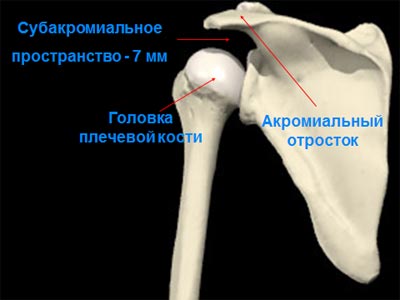
The subacromial impingement syndrome of the conflict (impingment syndrome)
Normally, there is no collision between the acromion and the head of the humerus. However, when the height of the space decreases, the reasons for which may be different, a collision becomes possible, which is why during movement, the above-mentioned structures of the rotator muscles are compressed, their chronic traumatization, and then damage.
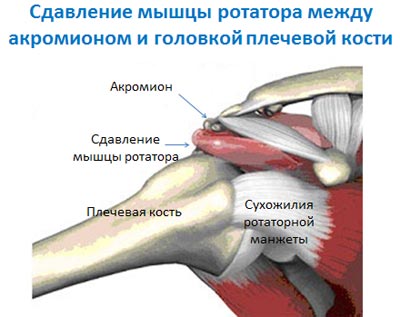
impeachment syndrome treatment
The most common causes of a decrease in the height of the space and the development of subacromial impingement syndrome are the structural features of the acromial process - curved or hook-shaped types of processes, incorrectly fused fractures of the large humerus or acromion, osteophytes, etc.
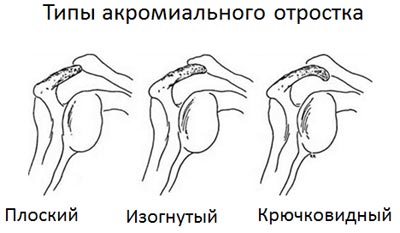
WHAT ARE THE SYMPTOMS OF SHOULDER IMPINGEMENT SYNDROME (SUBACROMIAL CONFLICT)?
The clinical manifestations of shoulder impingement syndrome are pain and restriction of movement in the shoulder joint during shoulder abduction and flexion.
The maximum pain is noted when the arm is withdrawn at an angle of 70-120°, i.e. in a position where the head of the humerus, with the muscles attached to it, is as close as possible to the lower edge of the acromion and clamps the rotator muscles.
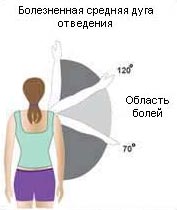
With further withdrawal, the pain decreases. This dynamics of pain during shoulder abduction is called "painful middle arc of abduction".
What are the symptoms of shoulder impingement syndrome?
WHAT IS THE DIAGNOSIS OF IMPINGEMENT SYNDROME OF THE SHOULDER (SUBACROMIAL CONFLICT)?
Clinical tests
For the diagnosis of impingement syndrome, special tests are used, in which the doctor, bringing the patient's hands to a certain position, artificially causes compression of the subacromial structures (causes additional pressing of the humerus head to the lower surface of the acromion) and looks at whether there is a characteristic pain syndrome or not. The diagnostic significance of these tests is extremely high, and the information content of some of them is at the level and even higher than that of an MRI examination of the shoulder.
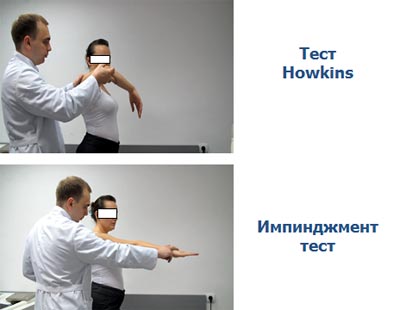
Clinical tests
The simplest and most informative diagnostic method that allows you to reliably distinguish subacromial conflict from other shoulder diseases is the NIRA test – the essence of which is a temporary decrease in the intensity of pain in the patient after injection of lidocaine into the subacromial bag.
Ultrasound diagnostics
MRI diagnostics
X-ray diagnostics
Arthroscopic diagnostics is the most reliable method of diagnosis. With the help of a modern device - an arthroscope, the doctor can examine all the structures of the joint from the inside and identify even the most minor injuries.
TREATMENT OF SHOULDER IMPINGEMENT SYNDROME (SUBACROMIAL CONFLICT)?
Treatment of shoulder impingement syndrome depends on the severity of the symptoms and the stage of the process. As a rule, in the initial stages of the disease, treatment begins with conservative measures:
Anti-inflammatory and therapy-taking non-steroidal anti-inflammatory drugs (NSAIDs).
Subacromial administration of glucocorticosteroids (blockade) - recommended for persistent pain syndrome. It is performed once a week, but no more than 3 injections during the year.
Physical therapy – ultrasound, magnetic therapy, electrotherapy.
Physical therapy-aimed at restoring the balance of the shoulder muscles, preventing the development of contractures-muscle spasms and tightness.
In the absence, within 3-4 months, of a positive effect from conservative therapy, surgical treatment is indicated.
SURGICAL TREATMENT OF SHOULDER IMPINGEMENT SYNDROME:
The most modern and low-traumatic method of surgical treatment of shoulder impingement syndrome is shoulder arthroscopy. Arthroscopy allows you to perform plastic acromion (in the case of hook-shaped or curved versions of the structure), remove osteophytes on the lower surface of the acromion, often located in the area of the articular surfaces of the clavicular-acromial joint, eliminate compression of muscles and tendons, restore their integrity.
WHAT AFFECTS THE RESULTS OF ARTHROSCOPY OF THE SHOULDER JOINT?
For high-quality performance of arthroscopy of the shoulder joint and obtaining the most successful results from the operation, 3 conditions are necessary:
Experienced orthopedic surgeon
Shoulder arthroscopy is a technologically more complex operation than, for example, knee arthroscopy. We can say that this is aerobatics, even for an experienced orthopedic surgeon engaged in arthroscopy of the joints. According to international standards, a surgeon who practices performing arthroscopic operations on the shoulder can be considered experienced if he has performed at least 1000 such operations, which is quite a difficult task.
Sufficient level of equipment for performing arthroscopy
It is necessary to have a full set of expensive high-tech equipment: a monitor, a digital video camera, an optical device (an astroscope with a diameter of 4 to 4.5 mm), a xenon light source with a power of at least 150 W, a device for supplying a solution that washes the joint during surgery (an arthroscopic pump), a device for coagulation and cutting tissues in solution (a vaporizer), a device for mechanical removal of soft and bone tissues. (shaver), a special set of tools for performing various types of restorative interventions. The absence of at least one of the above makes it impossible to perform a high-quality shoulder arthroscopy.
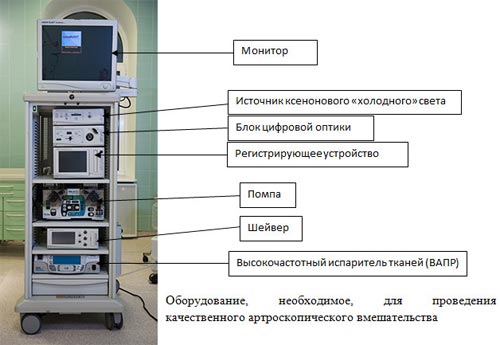
Adequate anaesthetic support
REHABILITATION AFTER ARTHROSCOPY OF THE SHOULDER JOINT:
properly performed surgery allows you to quickly start active rehabilitation, to prevent the development of complications and optimize the recovery time.
After arthroscopy of the shoulder, the arm is immobilized in the withdrawal position for several weeks with a special splint. This immobilization reduces the tension of the tendons and reduces the risk of re-rupture, creating favorable conditions for better healing of the tendon. The duration of immobilization is determined by the surgeon who performed the operation, since only he can assess the condition of the tendons and the strength of the suture performed.
From the first weeks after shoulder arthroscopy, patients are recommended to perform special exercises aimed at developing movements in the shoulder joint. However, their intensity and priority should be selected by the operating doctor and an experienced rehabilitologist.
In our Medical Center, patients after shoulder arthroscopy are offered a whole range of rehabilitation measures. The rehabilitation program is selected individually and includes:
Special exercises and physical therapy at the rehabilitation specialists of our Medical Center by the method of kinesiotherapy. Exercises are aimed at improving the volume of movement in the shoulder joint, preventing the development of contractures, increasing strength and endurance in the muscles of the shoulder girdle. The exercises are selected individually and performed on professional equipment in the rehabilitation hall, under the supervision of experienced rehabilitation instructors. Part of the exercises is signed to the patient for carrying out at home.
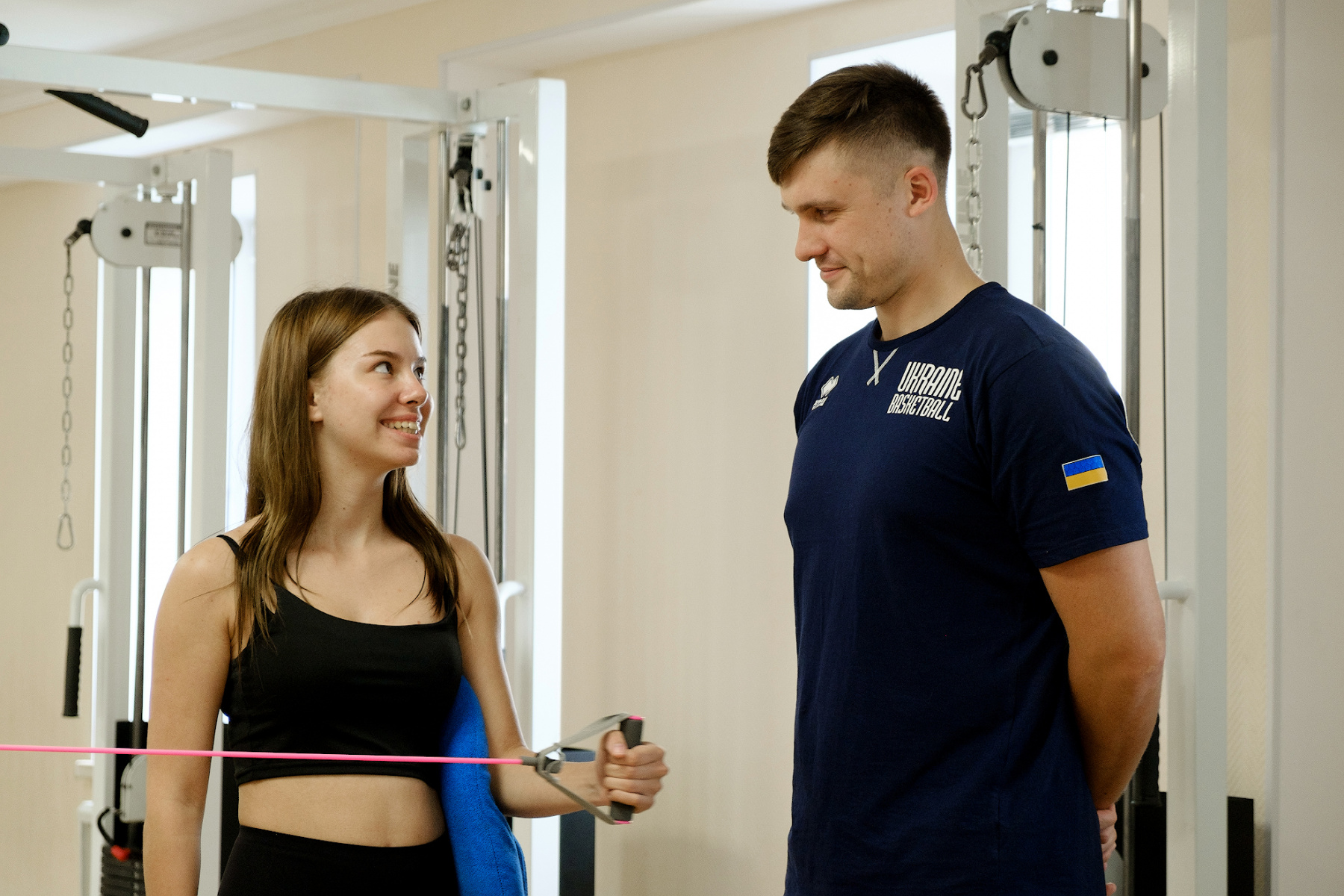
Physical therapy on the professional equipment of the BTL company: magnetic therapy, ultrasound therapy with the introduction of drugs, electrotherapy-reduce pain and swelling in the operated shoulder, prevent the formation of adhesions and scars, promote better healing, restore muscle tone.
At the heart of the shoulder impingement syndrome is an incorrect collision (conflict) between the acromion and the head of the humerus, which leads to compression and chronic injury of the tendons of the rotator cuff muscles during movement. The rotator cuff of the shoulder is located in the space between the acromial process of the scapula and the head of the humerus (Fig. 1). The height of this space is 6-7 mm, while the thickness of the rotator cuff is slightly less - 5-6 mm, which provides normal conditions for its sliding and prevents compression.

The subacromial impingement syndrome of the conflict (impingment syndrome)
Normally, there is no collision between the acromion and the head of the humerus. However, when the height of the space decreases, the reasons for which may be different, a collision becomes possible, which is why during movement, the above-mentioned structures of the rotator muscles are compressed, their chronic traumatization, and then damage.

impeachment syndrome treatment
The most common causes of a decrease in the height of the space and the development of subacromial impingement syndrome are the structural features of the acromial process - curved or hook-shaped types of processes, incorrectly fused fractures of the large humerus or acromion, osteophytes, etc.

WHAT ARE THE SYMPTOMS OF SHOULDER IMPINGEMENT SYNDROME (SUBACROMIAL CONFLICT)?
The clinical manifestations of shoulder impingement syndrome are pain and restriction of movement in the shoulder joint during shoulder abduction and flexion.
The maximum pain is noted when the arm is withdrawn at an angle of 70-120°, i.e. in a position where the head of the humerus, with the muscles attached to it, is as close as possible to the lower edge of the acromion and clamps the rotator muscles.

With further withdrawal, the pain decreases. This dynamics of pain during shoulder abduction is called "painful middle arc of abduction".
What are the symptoms of shoulder impingement syndrome?
WHAT IS THE DIAGNOSIS OF IMPINGEMENT SYNDROME OF THE SHOULDER (SUBACROMIAL CONFLICT)?
Clinical tests
For the diagnosis of impingement syndrome, special tests are used, in which the doctor, bringing the patient's hands to a certain position, artificially causes compression of the subacromial structures (causes additional pressing of the humerus head to the lower surface of the acromion) and looks at whether there is a characteristic pain syndrome or not. The diagnostic significance of these tests is extremely high, and the information content of some of them is at the level and even higher than that of an MRI examination of the shoulder.

Clinical tests
The simplest and most informative diagnostic method that allows you to reliably distinguish subacromial conflict from other shoulder diseases is the NIRA test – the essence of which is a temporary decrease in the intensity of pain in the patient after injection of lidocaine into the subacromial bag.
Ultrasound diagnostics
MRI diagnostics
X-ray diagnostics
Arthroscopic diagnostics is the most reliable method of diagnosis. With the help of a modern device - an arthroscope, the doctor can examine all the structures of the joint from the inside and identify even the most minor injuries.
TREATMENT OF SHOULDER IMPINGEMENT SYNDROME (SUBACROMIAL CONFLICT)?
Treatment of shoulder impingement syndrome depends on the severity of the symptoms and the stage of the process. As a rule, in the initial stages of the disease, treatment begins with conservative measures:
Anti-inflammatory and therapy-taking non-steroidal anti-inflammatory drugs (NSAIDs).
Subacromial administration of glucocorticosteroids (blockade) - recommended for persistent pain syndrome. It is performed once a week, but no more than 3 injections during the year.
Physical therapy – ultrasound, magnetic therapy, electrotherapy.
Physical therapy-aimed at restoring the balance of the shoulder muscles, preventing the development of contractures-muscle spasms and tightness.
In the absence, within 3-4 months, of a positive effect from conservative therapy, surgical treatment is indicated.
SURGICAL TREATMENT OF SHOULDER IMPINGEMENT SYNDROME:
The most modern and low-traumatic method of surgical treatment of shoulder impingement syndrome is shoulder arthroscopy. Arthroscopy allows you to perform plastic acromion (in the case of hook-shaped or curved versions of the structure), remove osteophytes on the lower surface of the acromion, often located in the area of the articular surfaces of the clavicular-acromial joint, eliminate compression of muscles and tendons, restore their integrity.
WHAT AFFECTS THE RESULTS OF ARTHROSCOPY OF THE SHOULDER JOINT?
For high-quality performance of arthroscopy of the shoulder joint and obtaining the most successful results from the operation, 3 conditions are necessary:
Experienced orthopedic surgeon
Shoulder arthroscopy is a technologically more complex operation than, for example, knee arthroscopy. We can say that this is aerobatics, even for an experienced orthopedic surgeon engaged in arthroscopy of the joints. According to international standards, a surgeon who practices performing arthroscopic operations on the shoulder can be considered experienced if he has performed at least 1000 such operations, which is quite a difficult task.
Sufficient level of equipment for performing arthroscopy
It is necessary to have a full set of expensive high-tech equipment: a monitor, a digital video camera, an optical device (an astroscope with a diameter of 4 to 4.5 mm), a xenon light source with a power of at least 150 W, a device for supplying a solution that washes the joint during surgery (an arthroscopic pump), a device for coagulation and cutting tissues in solution (a vaporizer), a device for mechanical removal of soft and bone tissues. (shaver), a special set of tools for performing various types of restorative interventions. The absence of at least one of the above makes it impossible to perform a high-quality shoulder arthroscopy.

Adequate anaesthetic support
REHABILITATION AFTER ARTHROSCOPY OF THE SHOULDER JOINT:
properly performed surgery allows you to quickly start active rehabilitation, to prevent the development of complications and optimize the recovery time.
After arthroscopy of the shoulder, the arm is immobilized in the withdrawal position for several weeks with a special splint. This immobilization reduces the tension of the tendons and reduces the risk of re-rupture, creating favorable conditions for better healing of the tendon. The duration of immobilization is determined by the surgeon who performed the operation, since only he can assess the condition of the tendons and the strength of the suture performed.
From the first weeks after shoulder arthroscopy, patients are recommended to perform special exercises aimed at developing movements in the shoulder joint. However, their intensity and priority should be selected by the operating doctor and an experienced rehabilitologist.
In our Medical Center, patients after shoulder arthroscopy are offered a whole range of rehabilitation measures. The rehabilitation program is selected individually and includes:
Special exercises and physical therapy at the rehabilitation specialists of our Medical Center by the method of kinesiotherapy. Exercises are aimed at improving the volume of movement in the shoulder joint, preventing the development of contractures, increasing strength and endurance in the muscles of the shoulder girdle. The exercises are selected individually and performed on professional equipment in the rehabilitation hall, under the supervision of experienced rehabilitation instructors. Part of the exercises is signed to the patient for carrying out at home.

Physical therapy on the professional equipment of the BTL company: magnetic therapy, ultrasound therapy with the introduction of drugs, electrotherapy-reduce pain and swelling in the operated shoulder, prevent the formation of adhesions and scars, promote better healing, restore muscle tone.
Product rating is: 2 from 5
Please rate the product:
Advantages of treatment in Orthopedics by Ruslan Sergienko
-
10 years on medical services in Ukraine
-
> 25 years of experience with leading specialists
-
Anna Vovchenko and Ruslan Sergienko are recognized opinion leaders among the orthopedic traumatologists
-
> 150,000 consultations were held
-
> 7,500 surgeries were performed
-
All types of pain management
-
The operating unit is equipped according to international standards
-
Availability of all medicines and supplies
-
Single rooms, equipped with the characteristics of orthopedic patients
-
Three meals a day
-
Postoperative rehabilitation by certified specialists
-
Pricing Transparency
